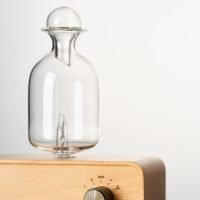Maintaining Your Nebulizing Essential Oil Diffuser: A Complete Cleaning and Care Guide

Welcome to our complete guide on maintaining your nebulizing essential oil diffuser, the key to ensuring optimal performance and delightful aromatherapy experiences. Whether you’re a seasoned essential oil enthusiast or a newcomer to the world of nebulizing essential oil diffusing, taking proper care of your nebulizing essential oil diffuser is crucial for its longevity. In this comprehensive guide, we will walk you through the step-by-step process of cleaning and caring for your diffuser, providing tips and tricks along the way. Say goodbye to clogged nozzles, diminished aromas, and ineffective diffusion – with our help, your nebulizing essential oil diffuser will continue to deliver the perfect scent and serenity, transform your space into a tranquil oasis. Say hello to effortless relaxation and a burst of aromatic bliss! Let’s explore how to keep your nebulizing essential oil diffuser as a dependable partner in your aromatic experience.
We recommend cleaning the glass reservoir on your nebulizing essential oil diffuser every seven days to prevent essential oil buildup and ensure optimal performance. switching between single scented essential oils in your nebulizing diffuser can be seamless if you give the glass reservoir a quick rinse with isopropyl alcohol. This prevents mixing of scents and maintains the purity of each aroma.
One important thing to mention is a nebulizing diffuser does NOT work with thicker essential oils as they will cause a blockage or a clog in the micro-tubes.
It’s also important to note that if you are planning on not use your nebulizing diffuser for some time you will want to clean any essential oil out of the glass reservoir to avoid the oil from drying inside the reservoir and/or the micro-tubes.
Regular maintenance ensures optimal performance, prevents clogging, and extends the lifespan of your diffuser. Here’s a simple guide to help you maintain your diffuser:
Weekly Cleaning Steps:
1. Turn Off the Diffuser:
– Ensure the diffuser is turned off and unplugged to avoid any electrical hazards.
2. Disassemble the Diffuser:
– Carefully remove the glass reservoir and any other detachable parts according to the manufacturer’s instructions.
3. Empty the Reservoir:
– Pour out any remaining essential oil from the reservoir. You can save it for later use if desired.
4. Rinse with Isopropyl Alcohol:
– Fill the reservoir with a small amount of isopropyl alcohol (rubbing alcohol).
– Swirl the alcohol around the reservoir to dissolve any residual oil. Use a cotton swab or soft cloth to clean hard-to-reach areas if necessary.
5. Soak if Necessary:
– If there is stubborn residue, let the reservoir soak in isopropyl alcohol for about 30 minutes to an hour.
6. Drain and Dry:
– Pour out the alcohol and let the reservoir air dry completely. You can also use a clean, soft cloth to dry it.
7. Reassemble the Diffuser:
– Once the reservoir is dry, reassemble the diffuser according to the manufacturer’s instructions.
8. Add Fresh Essential Oil:
– Add the desired amount of fresh essential oil to the clean reservoir.
– Turn on the diffuser and enjoy the pure, consistent aroma.
Additional Maintenance Tips
– Avoid Water:
– Do not use water to rinse the reservoir, as this can leave residue and affect the diffusion process.
– Check for Clogs:
– Regularly inspect the micro-tubes and other components for clogs, especially if you notice reduced mist output. Clean them as needed.
– Use High-Quality Oils:
– Stick to using 100% pure, therapeutic-grade essential oils. Lower quality oils can contain additives that may clog the diffuser.
By following these cleaning and maintenance tips, you can keep your nebulizing essential oil diffuser in top shape, ensuring it continues to deliver the perfect scent and serenity.
Deep Cleaning
If you find yourself with a really nasty clog that can not be cleaned using the general cleaning method with alcohol then we recommend giving your glass reservoir a deep cleaning.
Put on some dish washing gloves to protect your hands.
Prepare a container with boiling hot water (about 80 to 90C or 170 to 190F). CAREFUL!
Add a small amount of mild liquid dish soap and place the glass reservoir in the container with the mixture.
The combination of the hot water and soap will act to remove any staining, oil residue or any blockages that may have occurred.
Soak in the detergent and hot water for at least thirty minutes.
Take your glass reservoir out and gently wash with regular tap water. Then set the unit in a safe place to dry.
Once the glass reservoir is dry your cleanup is done!
One important thing to keep in mind is that a nebulizing diffuser does **not** work well with thicker pure essential oils. These oils can cause blockages or clogs in the micro-tubes of the diffuser. Here’s what you need to know:
Thicker Essential Oils to Avoid
Thicker essential oils are typically more viscous and can obstruct the nebulizing mechanism. Examples of these oils include:
– Sandalwood
– Vetiver
– Patchouli
– Cedarwood
– Myrrh
– Benzoin
Why Thicker Oils Cause Issues
Nebulizing diffusers work by using an air pump to atomize the essential oils into a fine mist. Thicker oils can clog the micro-tubes that atomize the oils, leading to:
– Reduced Mist Output: Thicker oils can block the pathways, resulting in little to no mist being produced.
– Inconsistent Performance: The diffuser might work intermittently or produce an uneven mist.
– Damage to the Diffuser: Prolonged use of thick oils can cause wear and tear, potentially damaging the diffuser.
Tips for Using Nebulizing Diffusers
1. Stick to Thinner Oils:
– Use oils that are known to be less viscous, such as lavender, peppermint, eucalyptus, lemon, and tea tree.
2. Blending with Thinner Oils:
– If you want to use a thicker oil, blend a small amount with a larger quantity of a thinner oil to reduce the overall viscosity. However, do this cautiously as it may still cause some clogging.
3. Regular Cleaning:
– Clean the diffuser more frequently if you use thicker oils or blends. This can help prevent any buildup and maintain optimal performance.
4. Check Compatibility:
– Refer to the manufacturer’s guidelines to ensure the oils you plan to use are compatible with your diffuser.
Maintenance and Troubleshooting
– Routine Cleaning:
– Regularly clean the diffuser with isopropyl alcohol to dissolve any residual oil and keep the micro-tubes clear.
– Inspect for Clogs:
– If you notice a decrease in performance, check for clogs in the micro-tubes and clean them thoroughly.
By avoiding thicker essential oils and following these tips, you can ensure that your nebulizing diffuser continues to function efficiently and provides a consistent, high-quality aromatic experience.
Warranty Registration
If you have questions or need help in any way please contact us right away at support@omsintdiffuser.com
